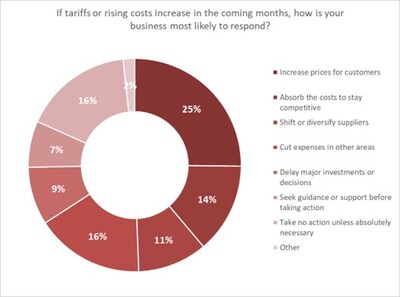Small business owners are navigating a challenging year with rising costs and shifting policies, yet many are building toward stability by tightening finances, exploring new ways to serve customers, and preparing for regulatory changes. A KeyBank survey of 2025 highlights a landscape where about a quarter of owners remain in survival mode, while a substantial share is cautiously planning for the future and aiming to strengthen their foundations. Despite pressures, a notable portion still shows resilience, confidence in decision-making, and a willingness to adapt as they work toward long-term growth.
Survey Insights: The Current State of Small Businesses
Economic pressures are reshaping how small businesses operate, invest, and plan for the medium and long term. The survey’s key figures offer a snapshot of a sector under stress yet capable of strategic recalibration. Approximately 23% of small business owners find themselves in survival mode, a state that signals a focus on immediate survivability rather than expansion or long-range planning. This doesn’t imply passivity; rather, it reflects a prioritization of core needs such as liquidity, cost control, and risk mitigation in a volatile environment.
In contrast, 40% of owners are forward-looking, actively planning for their businesses’ futures despite uncertainties. An even larger share—46%—feel their current performance did not meet their expectations for 2025, underscoring a broad sense of unmet goals and the desire to recalibrate. Among these mixed sentiments, another 46% emphasize preparedness by stating they could cover one month of operating expenses if an emergency arose. This figure is only slightly lower than a previous survey milestone (49%), indicating a persistent buffer that supports stability while planning for future resilience.
Inflation and rising costs are the dominant concerns for many owners. Half of the surveyed respondents (50%) identify inflation and the associated cost pressures as their top worry, surpassing concerns about competition (33%), cash flow (25%), and labor shortages and hiring challenges (22%). The proximity of inflation to the top worry highlights the margin pressures many small businesses face when costs climb while pricing power may be constrained by market dynamics and tariff-driven price increases.
Pricing responses to cost shifts are already evident. A quarter (25%) of owners are raising prices for customers in light of recent tariffs and rising costs. This pricing strategy reflects the balancing act between maintaining demand and preserving margins in a costlier operating environment. Cybersecurity also remains a central concern, with 41% naming payment fraud as their principal worry, followed by phishing and email scams (27%) and identity theft (26%). These figures underscore the heightened focus on protecting financial transactions and customer data amid an increasingly digital operating environment.
Policy changes loom large on the horizon. With federal legislation changes anticipated in the latter part of 2025, 72% of small business owners express serious concern about the potential impact on their operations. Yet a sense of confidence persists: 80% say they feel capable of making key, informed decisions despite today’s economic and policy uncertainty, even if they occasionally second-guess themselves.
As the survey’s author and KeyBank’s leadership emphasize, the current environment requires a blend of grit, adaptability, and prudent planning. The following sections unpack what these numbers mean for resilience, strategy, and practical steps owners can take to navigate toward stability and growth.
The Human Element: Resilience and Ambition
Mike Walters, President of Business Banking at KeyBank, frames the findings as a testament to the persistence and creativity at the core of small business communities. He notes that owners’ willingness to tighten expenses, explore new service models, and prepare for regulatory shifts demonstrates the grit that underpins long-term growth. This perspective helps explain why a sizable portion of owners remains confident enough to plan and invest, even as many still grapple with present-day pressures.
Looking Ahead: The 2026 Horizon for Small Businesses
Looking toward 2026, owners are prioritizing strategies, resources, and self-care that contribute to resilience. The survey highlights that many seek professional guidance—specifically with business bankers—because they feel more secure through regular conversations and guidance on cash flow (33%), financial planning (33%), and tax strategy (31%). The emphasis on advisory relationships signals a recognition that sound financial management, rather than mere cost-cutting, will be crucial to sustainable growth.
Additionally, personal resilience factors into business stamina. About 30% of owners say they feel more resilient when they get a good night’s sleep, underscoring the link between personal well-being and strategic decision-making. The overarching message is that resilience is not solely a financial construct; it encompasses preparation, perspective, and the wellness required to execute plans effectively.
Economic Pressures and Business Adaptation
The path through 2025 is shaped by rising costs, tariff dynamics, and the need to realign pricing, operations, and customer engagement. The data point that 25% of owners have raised prices in response to tariffs and cost pressures illustrates a direct response to macroeconomic shifts. This adjustment is a strategic lever to preserve margins, but it also carries risks in terms of customer willingness to absorb higher prices, sensitivity in competitive markets, and potential demand elasticity.
Cost-management strategies are therefore essential levers for stability. Businesses are reevaluating supplier contracts, negotiating terms to reduce working capital needs, and seeking more favorable payment terms to smooth cash flow. Some are accelerating efficiency improvements, such as process optimization, automation where feasible, and the reduction of nonessential expenditures. In parallel, owners are exploring revenue diversification—adding products or services, expanding into new customer segments, or leveraging digital channels to reach broader audiences.
Tariffs and geopolitical shifts create price variability that complicates forecasting. The need to assess risk exposure across supply chains, identify alternative sourcing, and build contingency plans becomes more pronounced. Companies that can segment customers by price sensitivity and adapt messaging accordingly are likely to maintain demand while safeguarding profitability. These approaches require data-driven decision-making, cross-functional collaboration, and access to timely market intelligence, all of which are areas where small businesses sometimes partner with financial institutions or advisory services for guidance.
The prominence of cybersecurity concerns underscores a dual challenge: safeguarding financial transactions and protecting customer data in an increasingly digital environment. The emphasis on payment fraud suggests that owners recognize the need for robust payment controls, monitoring, and fraud mitigation tools. Phishing and identity theft worries further highlight the importance of employee training, secure authentication practices, and the use of layered security measures. When combined with cost pressures, cybersecurity readiness becomes a strategic investment that supports reliable operations and customer trust.
Practical Adaptation Strategies
-
Price and value strategy: Communicate value clearly, justify price adjustments with tangible benefits, and offer flexible pricing or bundles to retain customers who may be price-sensitive.
-
Cost optimization: Audit overhead, renegotiate vendor terms, and pursue scalable technology that drives efficiency without sacrificing quality.
-
Revenue diversification: Introduce new services or cross-sell related offerings to existing customers, expanding revenue streams while leveraging current relationships.
-
Digital transformation: Invest in online channels, e-commerce, and contactless payment options to improve convenience and capture broader demand.
-
Cash flow discipline: Implement more precise forecasting, scenario planning, and sensitivity analyses to anticipate liquidity needs under different market conditions.
-
Cybersecurity investment: Strengthen payment controls, deploy multi-factor authentication, conduct staff training on cybersecurity basics, and consider cyber insurance where appropriate.
Financial Readiness and Cash Flow Management
Cash flow resilience is a central theme in the survey, reflected in the finding that 46% believe their 2025 performance fell short of expectations and 46% could cover one month of operating expenses in an emergency. These metrics reveal a dual reality: many owners still maintain a modest liquidity cushion, but the environment calls for greater confidence in liquidity management and contingency planning. The ability to withstand a cash crunch and continue operating hinges on the quality of financial visibility, the speed of decision-making, and access to affordable liquidity options.
Liquidity planning begins with robust cash flow forecasting. Small businesses should build forward-looking models that capture revenue seasonality, payment cycles, and potential delays in accounts receivable. Sensitivity analyses help owners understand how changes in sales, margins, or input costs affect liquidity. Regular reviews with banking partners or financial advisors can help translate these forecasts into actionable borrowing strategies, working capital optimization, and risk mitigation plans.
Beyond forecasting, maintaining a cash reserve that covers multiple months of operating expenses is a prudent resilience measure. The data shows 46% feel poised to weather temporary shocks; expanding this cushion through disciplined savings, contingency lines of credit, and access to credit when conditions are favorable can provide additional runway. This approach becomes even more important as inflation and tariff-related cost pressures persist and as regulatory uncertainties loom.
Treasury management practices also play a critical role. Businesses should aim to optimize working capital through efficient receivables processes, negotiating favorable payment terms with suppliers, and reducing days payable outstanding where possible without harming supplier relationships. In parallel, maintaining transparent and timely financial reporting helps ensure owners and stakeholders stay aligned and prepared for strategic shifts.
Practical Cash Flow Practices
-
Build comprehensive cash flow forecasts with monthly granularity and scenario planning for best-case, worst-case, and most-likely scenarios.
-
Establish and maintain a dedicated liquidity buffer that aligns with the business’s risk tolerance and volatility in revenue streams.
-
Implement strong receivables discipline, including prompt invoicing, clear payment terms, and proactive collections processes.
-
Negotiate favorable supplier terms or volume discounts to improve working capital.
-
Use credit facilities strategically to smooth gaps in cash flow, rather than as a default funding source.
-
Regularly review profitability by product line or service offering to identify areas where margins can be improved without compromising growth.
Cybersecurity and Risk Management
The survey’s cybersecurity findings reflect a clear, two-pronged priority: protect payment processes and defend against identity-based threats. With 41% of owners naming payment fraud as their top concern, small businesses are confronted with the everyday reality of fraudulent transactions, card-not-present risks, and potentially compromised accounts. The emphasis on phishing (27%) and identity theft (26%) further underscores the vulnerability of human and digital interfaces to social engineering and credential theft.
Strengthening cybersecurity requires a layered approach that combines technology, process, and culture. Technical measures include strong authentication for financial platforms, encryption for data in transit and at rest, real-time monitoring for unusual transactions, and segmentation of sensitive systems. Process-wise, firms should implement strict access controls, dual approvals for large or unusual payments, and routine reconciliation to quickly detect discrepancies. Regular employee training on recognizing phishing attempts, securing devices, and maintaining password hygiene is essential to reduce risk at the source.
Insurance and incident response planning are critical components of resilience. Small businesses should assess cyber liability coverage options and understand policy scopes, limits, and exclusions. An incident response plan that defines roles, communication procedures, and recovery steps can dramatically shorten downtime after a security event. In the broader risk landscape, owners should maintain vendor risk management practices to minimize third-party exposure, given the potential for breaches or disruptions through connected service providers.
Best Practices for Small Businesses
-
Implement multi-factor authentication and role-based access controls for critical systems.
-
Enforce strict payment controls, including approval workflows and transaction limits.
-
Schedule regular security awareness training for all employees and contractors.
-
Conduct periodic security assessments, including phishing simulations and vulnerability scans.
-
Maintain a cyber insurance policy with explicit coverage for key scenarios your business faces.
-
Develop and rehearse an incident response and disaster recovery plan.
-
Build a vendor risk management program to assess and monitor third-party security practices.
Policy Environment and Regulatory Outlook
The survey captures a notable degree of anticipation and anxiety regarding policy shifts. With a substantial 72% of owners expressing concern about the impact of upcoming federal legislation on their operations, regulatory developments loom large as a potential source of both risk and opportunity. The environment invites proactive planning, such as scenario analysis for regulatory changes, compliance readiness checks, and ongoing engagement with policymakers or industry groups to understand potential trajectories.
Businesses can translate policy awareness into practical preparedness. This includes monitoring compliance requirements that may affect payroll, tax, reporting, or industry-specific standards; establishing internal governance processes to respond quickly to new rules; and seeking advisory support to interpret and implement changes efficiently. While policy changes can introduce uncertainty, they also create a context in which well-prepared firms differentiate themselves through robust governance, transparent practices, and demonstrated reliability to customers and partners.
Operationally, the policy environment affects decisions about capital investments, hiring, and pricing strategies. For example, anticipated changes in tax policy, deductions, or treatment of certain business activities can alter after-tax profitability and cash flow planning. Entities that maintain flexibility in budgeting and maintain strong a relationship with financial partners may be better positioned to adapt to evolving regulatory landscapes.
How to Prepare for Regulatory Shifts
-
Establish a cross-functional regulatory watch function within the business, including finance, compliance, and operations leads, to interpret potential impacts.
-
Maintain flexible budgeting that can accommodate policy-driven changes in taxes, incentives, or regulatory costs.
-
Build a communication plan for customers and employees that clearly explains any changes that may affect pricing, benefits, or compliance.
-
Engage with bankers or advisors who can translate regulatory developments into concrete financial strategies.
-
Consider scenario planning exercises that model outcomes under different policy environments to inform strategic choices.
Advisory Resources and Programs
The survey references structured advisory support as a meaningful driver of resilience. Specifically, programs such as the Certified Cash Flow Advisor initiative offer a framework for small businesses to receive guidance tailored to cash flow and financial challenges, with an emphasis on optimizing operations and sustaining liquidity in the face of uncertainty. Locking in qualified guidance helps owners translate financial data into actionable plans, enabling more effective management of working capital, debt, and growth opportunities.
Owners are encouraged to seek regular conversations with business bankers or financial advisors to fortify confidence in decision-making. Access to professional advice supports better cash flow planning, financial forecasting, and tax strategy—areas where small businesses often encounter complexity and volatility. Establishing a trusted advisory relationship can also provide a sounding board for strategic pivots, such as pricing changes, product diversification, or investment in resilience-enhancing capabilities.
Integrating Advisory Services into Daily Practice
-
Schedule regular, structured reviews of cash flow, budgets, and forecasts with a financial professional.
-
Use advisory insights to inform strategic decisions about pricing, debt management, and capital investments.
-
Leverage advisory programs to access tools for scenario planning, risk assessment, and performance benchmarking.
-
Align advisory guidance with business goals, ensuring that recommendations are practical, implementable, and time-bound.
-
Document action plans and track progress to maintain accountability and momentum.
Preparing for 2026: Resilience, Self-Care, and Strategic Focus
A forward-looking mindset emphasizes resilience as a composite of planning, advisory support, and personal well-being. The survey’s emphasis on self-care—such as getting a good night’s sleep—highlights the link between personal health and professional performance. Resilience is not simply about weathering the current environment; it is about designing a framework that supports sustained growth, adapts to change, and maintains the capacity to make informed decisions under pressure.
Owners who combine strategic foresight with practical, day-to-day discipline are better positioned to translate macroeconomic shifts into opportunities. The focus on cash flow management, cost discipline, and customer-focused adaptation creates a foundation for resilient growth. In particular, preparing for policy changes and regulatory shifts helps ensure continuity, while maintaining a strong advisory network reduces the risk of missteps during periods of uncertainty.
The roadmap for 2026 centers on three pillars: strategic planning supported by trusted advisors, disciplined financial management that emphasizes liquidity and risk mitigation, and a robust approach to cybersecurity and risk management that protects both the business and its customers. By blending these elements, small businesses can create a sustainable engine for growth, even when external conditions remain unsettled.
Tactical Steps for Next Year
-
Formalize a 2026 strategic plan that incorporates market analysis, customer insights, cost structure reviews, and potential regulatory scenarios.
-
Strengthen advisor relationships to provide ongoing, timely guidance on cash flow, tax planning, and strategic investments.
-
Invest in cybersecurity hygiene and risk governance to safeguard operations and preserve customer trust.
-
Build personal resilience routines that support consistent decision-making and leadership effectiveness.
-
Communicate transparently with customers about value, pricing changes, and service enhancements that reinforce loyalty.
-
Monitor inflationary and tariff-related developments and adjust pricing, procurement, and product strategies accordingly.
Conclusion
In a year marked by cost pressures, tariff dynamics, and regulatory ambiguity, small business owners are demonstrating a blend of caution and resolve. The KeyBank survey paints a portrait of a sector contending with elevated inflation, pricing pressures, and cybersecurity risks, while also leveraging advisory partnerships, disciplined cash flow practices, and strategic planning to build stronger foundations for the future. A sizable portion of owners remains confident in their ability to make informed decisions, even as they acknowledge the need for vigilance and adaptation.
The data underscores a dual reality: a substantial number of businesses are tightening operational levers to survive in the near term, while an equally important cohort is investing in planning, resilience, and growth initiatives that can sustain long-term success. As 2026 approaches, the most successful firms will likely be those that fuse robust financial management with proactive risk mitigation, while maintaining a clear focus on customer value and service excellence. The ongoing emphasis on professional guidance and structured cash flow initiatives points to a future where small businesses increasingly rely on trusted partnerships to navigate a complex economic and policy landscape. By continuing to prioritize resilience, strategic clarity, and cybersecurity, small businesses can turn today’s challenges into tomorrow’s competitive advantages.



